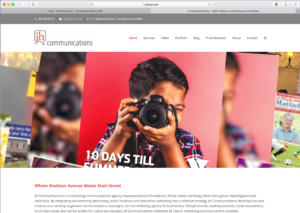 With all this new found time on our hands, and even more time online, there has never been a better time than now to update your website. Unless you’re in the e-commerce space and you’re updating your website on a daily basis, most B2B and B2C businesses could use a freshening up of their online presence.
With all this new found time on our hands, and even more time online, there has never been a better time than now to update your website. Unless you’re in the e-commerce space and you’re updating your website on a daily basis, most B2B and B2C businesses could use a freshening up of their online presence.
You don’t need to completely overhaul your website. You’re not starting from scratch. You’re building on the platform that has taken you this far and adapting it to today’s consumers.
Having developed hundreds of websites for a wide array of organizations, we wanted to share with you the indisputable top ten, must-haves of every website.
10. HTTPS secure hosting. If the first thing a visitor sees when going to your website is “unsecure,” that’s not helping you build confidence in your brand. You need to have an SSL certificate to assure the web visitor that your site is secure and that you have taken the necessary steps to safeguard their information. This is going to cost you about $75 to add a secure socket layer to your website, and like taxes, it’s one of those necessary evils for being in business.
9. Add video to make your site more interactive. Many websites use video images in their banners to make their websites more interactive. Videos can also be utilized to welcome people to your website or demonstrate the ease of use of your product. While video can make your website more dynamic, it can also make it stale if you do not commit to updating videos on a quarterly basis.
8. Keep your word count to 300 words per page. If you’ve gotten this far, you have read 300 words. From this point up to the title is the right amount of words you should have on each page of your website to meet the recommended word count for SEO best practices.
7. Invest in an SEO plugin like Yoast. Yoast works with WordPress websites and will guide you through making your website SEO friendly. In addition to word count, it will show you how to have relative search words in your headings. You can have the most visually appealing website but if you cannot be found by potential customers it’s really not doing its job.
6. Add your social media feed to keep your content fresh. One easy way to keep your content current is to have your social media feed embedded into your website. Social media platforms were designed for quick updates, and you can use your feed to alert visitors how active you are in the community, events you’re sponsoring, or businesses you’re supporting. If you have a tendency to post the same content on multiple feeds, you may want to just include your primary social media account on your website so visitors don’t see duplicate content.
5. Make sure your pictures are not copyrighted. You can’t just take whatever picture you like from the Internet and place it on your website. If you’re a bar, restaurant, or entertainment venue, you especially cannot use photos of celebrities on your website. There is now software that scans websites looking for copyrighted photos. Please make sure you are using images from stock image sites and royalty free galleries, so you don’t have to pay for having the wrong photos on your site.
4. Let me see who I’m buying from. I understand people’s privacy, but if you’re in a service business, then I think you should be able to see pictures of the people servicing you. In addition to seeing head shots of the people working on my account, ideally it’s even better to use real life photos of your actual people rather than stock photos. How hard is it to have a photographer come in for a few hours to take candid shots of your staff, instead of having to use fake stock photos. Instead of the cliche shaking hand shots of two clients, how about an actual handshake with a real customer.
3. Know who’s checking you out. Inbound marketing software, like HubSpot or SharpSpring, will allow you to take a glance at who’s on your website. You can see the domain addresses of those organizations visiting your website, so if you’re pitching a big company you may see what pages they’re visiting. You can also track your contacts to view which pages they’re visiting most frequently. If you see the same contact going back to certain product pages, you may want to reach out to that person.
2. Make it easy to buy. You don’t ever want to have a prospective buyer searching for how to get a hold of you. You want a contact form or direct phone number to reach you if you have a prospect ready to buy. I also like having case studies on portfolio pages to provide real examples of how you provided a real life business solution for an actual business.
1. Build your websites for your visitors, not for you. This is not about you. It’s for the customer. Start with your website’s visitor in mind and you will never steer them wrong. We don’t need pages focused on you. We need examples of how you can provide solutions. One way to illustrate satisfied customers is by featuring testimonials by real people. It’s better to have actual people tell others how great you are than hearing it from you.
If you have questions about marketing-communications, or have a topic you would like covered, please reach out to John Houle at john@jhcom.net.
